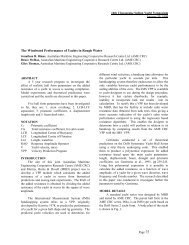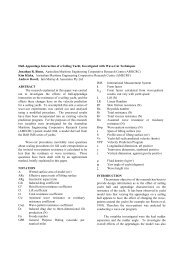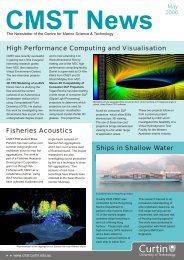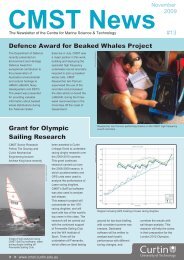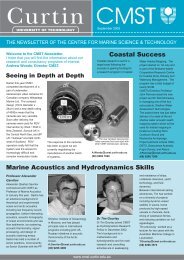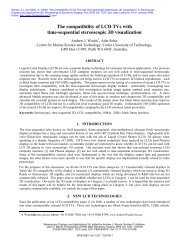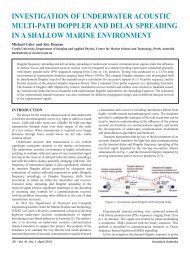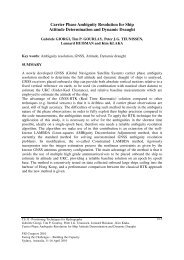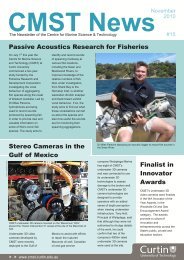Blue whale calling in the Rottnest trench-2000, Western ... - ANP
Blue whale calling in the Rottnest trench-2000, Western ... - ANP
Blue whale calling in the Rottnest trench-2000, Western ... - ANP
You also want an ePaper? Increase the reach of your titles
YUMPU automatically turns print PDFs into web optimized ePapers that Google loves.
Figure 42: Distribution of <strong>the</strong> number of <strong>call<strong>in</strong>g</strong> blue <strong>whale</strong>s per block from 998 manually counted 90 s blocks of <strong>the</strong><br />
bluey logger set.<br />
The automatic search technique located each component with<strong>in</strong> <strong>the</strong> block. This enabled <strong>the</strong> level<br />
of <strong>the</strong> call to be determ<strong>in</strong>ed. For <strong>the</strong> bluey logger data set, this was done by:<br />
• select<strong>in</strong>g a section of <strong>the</strong> waveform from 2 s before to 5 s after <strong>the</strong> identified component<br />
central po<strong>in</strong>t (adjusted appropriately if <strong>the</strong> selected times fell outside <strong>the</strong> actual times)<br />
• calculat<strong>in</strong>g <strong>the</strong> power spectra of this section at a 0.61 Hz resolution us<strong>in</strong>g a Hann<strong>in</strong>g w<strong>in</strong>dow<br />
and no overlap (5 averages for a full seven second section);<br />
• f<strong>in</strong>d<strong>in</strong>g <strong>the</strong> spectral peak with<strong>in</strong> <strong>the</strong> frequency bands 20-26 Hz or 16-19.5 Hz for <strong>the</strong> type II<br />
or type III component respectively;<br />
• convert<strong>in</strong>g <strong>the</strong> spectral peak level over <strong>the</strong> selected frequency band to mean squared pressure<br />
us<strong>in</strong>g <strong>the</strong> empirical relationship given <strong>in</strong> section 3.1.3 (type III components were assumed to<br />
have <strong>the</strong> same relationship between spectral level and mean squared pressure as per Equation<br />
1, and from 3.1.2 were assumed to have a 2 dB lower source level than <strong>the</strong> type II<br />
components).<br />
By return<strong>in</strong>g <strong>the</strong> spectral level over a narrow frequency band <strong>the</strong> chance of extraneous sources<br />
alter<strong>in</strong>g <strong>the</strong> component measured level was m<strong>in</strong>imised. A problem with this analysis was that <strong>the</strong><br />
received level of many blue <strong>whale</strong> components varied throughout <strong>the</strong> component, <strong>in</strong> several<br />
ways (ie. Figure 13). Hence measur<strong>in</strong>g a small section of <strong>the</strong> component may give a slightly<br />
different received level as compared to measur<strong>in</strong>g <strong>the</strong> entire component. But this error may be<br />
expected to be small, and when averaged over many samples of received signals, not significant.<br />
The distribution of calculated type II component mean squared pressure values is displayed <strong>in</strong><br />
Figure 45 along with an overlaid curve for <strong>the</strong> received level of an equal number of <strong>the</strong>oretical<br />
blue <strong>whale</strong> calls, spaced evenly at one km <strong>in</strong>crements <strong>in</strong> a l<strong>in</strong>e from 280 km south to 280 km<br />
north with a propagation loss of 15 log10 (range). Assum<strong>in</strong>g <strong>the</strong> region of <strong>the</strong> <strong>Rottnest</strong> <strong>trench</strong> to<br />
be def<strong>in</strong>ed as with<strong>in</strong> 40 km of <strong>the</strong> bluey logger site, or rang<strong>in</strong>g from Yanchep <strong>in</strong> <strong>the</strong> north to <strong>the</strong><br />
sou<strong>the</strong>rn end of Garden Island <strong>in</strong> <strong>the</strong> south, <strong>the</strong>n <strong>the</strong> propagation calculations of <strong>the</strong> type II<br />
component from <strong>the</strong> bottomed bluey logger (ie. 95% probability of detection ranges Figure 26,<br />
Figure 27 and Figure 28) suggest that those signals above approximately 110 dB re 1μPa (mean<br />
squared pressure) were <strong>in</strong> <strong>the</strong> <strong>trench</strong> region. This assumes:<br />
1. that most animals were located along <strong>the</strong> shelf edge, or along transects 1 (N), 4 (SE), 5 (S)<br />
and 6 (SW) and extrapolates <strong>the</strong> trend of <strong>the</strong> 95% probability curve for transect 1 beyond <strong>the</strong><br />
transect length limitation;<br />
42



